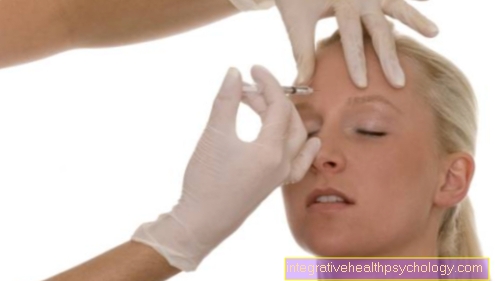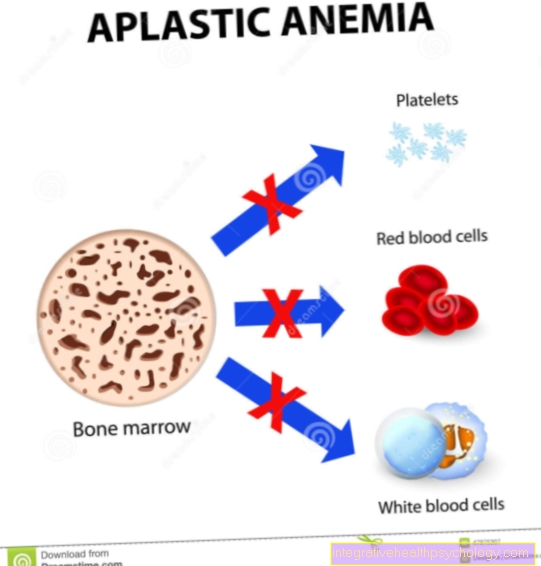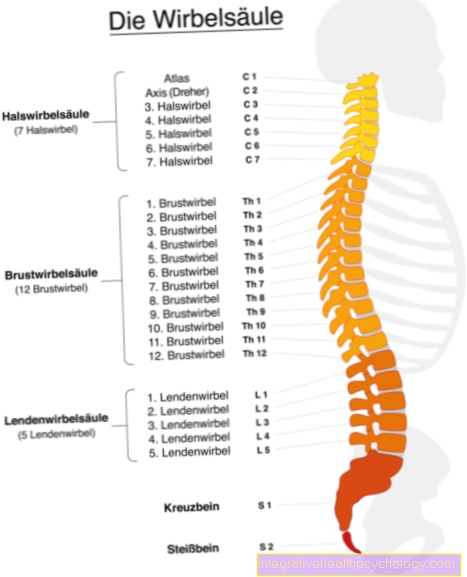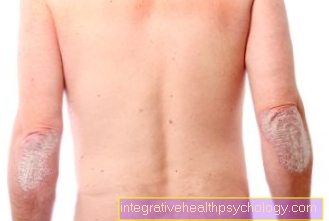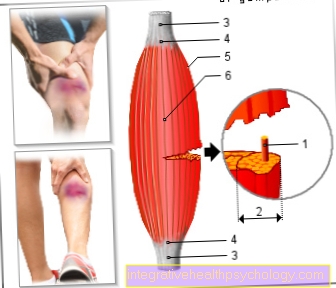Facial palsy
Definition - What is Facial Palsy?
Facial paralysis is the paralysis of a so-called cranial nerve, namely the facial nerve. It is also known as the seventh cranial nerve and has its origin in the brain stem. From there it moves through various structures to the muscles of the face, which it is responsible for moving. In the case of paralysis, the transmission of the signals of the facial nerve no longer works properly, which is why some of the facial muscles fail. The cause of facial palsy is often unclear, but it can also result from injuries or infections. Treatment usually consists of the administration of cortisone, which is very effective. Therefore, facial palsy also has a good prognosis.

When treating facial nerve palsy, a distinction can be made between general measures and treatment of the cause.
General measures include physiotherapy of the affected muscles in order to strengthen them and prevent muscle tissue decline. It is also very important that the eye is protected from dehydration when there is reduced tear production or even if the eyelid has failed to close. Tear substitutes and eye ointments that clean the eye and keep it moist are suitable for this. If the eyelid can no longer be closed, a so-called watch glass bandage should be put on at night to protect the eye.
Read more on this topic at: Artificial tear fluid
Since the cause of the facial nerve palsy cannot be clarified in most cases, the cortisone preparation prednisolone is recommended for 5-10 days in the form of tablets. If an infection is detected, antibiotics or antivirals, i.e. drugs against the bacteria or viruses, must be given. If the facial paralysis is due to an injury or a tumor, it is removed with the help of an operation, if possible.
These exercises can help
With facial palsy, it is important that the affected muscles are strengthened early on. This is not only for cosmetic reasons, but also serves as a prevention against a breakdown of the muscle tissue, which would otherwise occur if the device is not used for a long time. There are various exercises that can be instructed by physiotherapy. However, it is also very important to do this at home regularly, preferably several times a day for 10-20 minutes, if necessary in front of a mirror if you need help. Care should be taken to ensure that the sick side in particular is trained. If an exercise is not yet working properly, two fingers can be used initially.
Depending on the muscles affected, the exercises include strengthening the forehead with several frowns and raising eyebrows. The eyes can also be strengthened by opening and closing them several times. This also includes blinking several times and focused looking into the distance. The nose can be trained by pulling it up and down several times and by moving the nostrils. Mouth exercises include showing your teeth, tipping your lips, pressing your lips together, and smiling with your mouth closed and open. It also helps to inflate and suck in the jaws.
Can Vitamin B Help?
Vitamin B, especially vitamin B12, is an important substance for the nerves in the human body, as it supports them in their function and increases the conduction speed for the transmission of information. It is therefore generally important to consume enough vitamin B, as the body cannot produce it itself. Nowadays, vitamin B is often given in addition to other drugs to support facial palsy in order to reactivate the nerves. However, the vitamin alone cannot cure facial palsy.
Read more on this topic at:
- Vitamin B12
- Vitamin B complex
Electrical stimulation
Electrical stimulation can be helpful in paralyzing some nerves, but is not recommended for facial palsy. There is no scientific evidence or studies that electrical stimulation can improve facial palsy. In addition, spasms, i.e. unwanted strong, rapid muscle contractions in the facial area can be triggered instead. Depending on the location of the stimulation, these also have negative effects on the surrounding areas of the face and are perceived as very unpleasant by the treated people.
Read more on this topic at: Electrical stimulation
Duration
The duration of a facial palsy depends on various factors, which is why no general statement can be made about it.
In most cases, facial palsy is idiopathic, so no coherent cause can be found. If it is noticed early by those affected, it can be quickly treated with prednisolone for 5-10 days. As a result, about 80% of all those affected heal completely, which means that the total duration is about 2-3 weeks. Occasionally, however, the therapy does not work or works only insufficiently.
If there is no improvement within the first three weeks after the start of therapy, this has an adverse effect on the prognosis, which also increases the duration of the facial nerve palsy. Other unfavorable factors that increase the duration of facial palsy are the occurrence of the disease in old age and the presence of complete paresis of the nerve. In addition, the duration of other causes, such as an infection, trauma or tumor, depends on how well the respective cause can be treated. For this purpose, drugs or surgical methods are available, depending on the situation.
forecast
The prognosis of facial palsy depends on the underlying cause. In the so-called idiopathic facial nerve palsy, in which no exact cause can be found and which makes up approx. 70% of all cases, the chance of a complete cure is 80%. Every now and then the therapy does not work or works only insufficiently, which leaves permanent damage from the facial nerve palsy. Most of the time, you can lead a normal life despite the weakened muscles. Occasionally there is a faulty regrowth of the nerve after damage. As a result, so-called crocodile tears can occur, for example, and those affected get tears in their eyes while eating, due to the connection between the tear and salivary glands.
causes
The causes of facial palsy are very different. In fact, it remains unexplained in around 70% of all cases. This is also known as idiopathic. Facial nerve palsy suddenly occurs without an explainable connection being found.
Occasionally, however, a cause can also be identified as such. Inflammation is often responsible for facial paralysis, usually due to infection with a pathogen. Borreliosis is probably the best-known infection that occurs especially in children. One then speaks of neuroborreliosis, as it affects a nerve. But a herpes zoster infection is also a possible cause. In the so-called Ramsay Hunt syndrome caused by the herpes viruses, there is zoster oticus, i.e. a painful rash in the area of the ear canal, with ear pain and facial palsy.
In very rare cases, tuberculosis or syphilis can cause facial palsy. Mechanical injuries to the nerve, for example during dental treatment or a broken bone, can also lead to paralysis of the cranial nerve. Furthermore, tumors, for example of the parotid gland, diabetes mellitus, Guillain-Barré syndrome or a complicated otitis media, can occasionally be the cause of facial paralysis.
Read more on this topic at:
- Neuroborreliosis
- Herpes zoster oticus
After a dental treatment
Very rarely, facial paralysis can occur even after dental treatment. The reason for this is that local anesthesia is required for many dental procedures. This is also known as conduction anesthesia, as it is usually placed in the area of a nerve in such a way that its conduction temporarily no longer works for a certain section. If the facial nerve is accidentally damaged, it can lead to facial palsy. This occurs either immediately or after a few days and should be treated as soon as possible. Often times, symptoms improve as soon as the anesthetic wears off.
diagnosis
Usually, facial palsy can be diagnosed based on a physical exam. Since the facial muscles no longer work in facial paralysis, this can be checked relatively easily using simple tests. The person concerned is asked to frown or show their teeth, for example. Usually only one half of the face is affected by the facial paralysis, which means that these simple tests reveal paralysis of the nerve relatively quickly. If an infection is suspected, the blood and, if necessary, the cerebral fluid should also be examined with the help of a lumbar puncture. Imaging, e.g. CT is usually not necessary for facial palsy.
Read more on this topic at: Lumbar puncture
What is the difference between central and peripheral facial palsy?
In order to understand the difference between central and peripheral facial nerve palsy, one has to take a closer look at the course of the cranial nerve. Everyone has two facial nerves that originate in two small nuclei (a right and a left nucleus) in the brain stem. However, the command to move the muscles comes from higher up via other fibers.
These fibers in turn originate in the cerebrum. This is an area of the brain that is responsible for controlling all muscles. From there the fibers pull down to the nuclei in the brain stem. On the way there, some of them cross to the other side. The right nucleus in the brain stem receives information from both the right hemisphere and the left hemisphere, and vice versa.
If central facial palsy occurs, the fibers in the cerebrum are affected. As a result, the nerve supply to the facial muscles on the opposite side of the damage is lost because some of the fibers cross to the other side on the way to the brain stem. This part is mainly responsible for the muscles of the mouth, nose and cheeks. The person concerned can e.g. no longer showing their teeth or wrinkling their noses.
The muscles in the area of the eyes and forehead are still intact, however, as these fibers both cross and pull straight down from their brain hemisphere. These muscles are controlled by fibers from both halves of the brain and are therefore not impaired in the case of central facial paralysis.
In peripheral facial palsy, the nucleus in the brain stem or the nerve on the way to the muscles is damaged. As a result, all muscles on the side of the damage fail and the affected person can no longer frown or close their eyes on this side.
Read more on this topic at: Facial nerve
Who Treats Facial Palsy?
Facial palsy is damage to a nerve. Therefore, it should be treated by a neurologist, i.e. a doctor specializing in neurology. Every now and then, people with facial palsy first go to a family doctor because they don't know exactly how to classify these symptoms. The family doctor can then issue a referral for a neurologist. Depending on the cause, the neurologist can, for example, call in an ear, nose and throat specialist in the case of a tumor disease.
I recognize facial nerve palsy from these symptoms
Facial paralysis usually results in relatively impressive symptoms, which is why this nerve paralysis can often be easily recognized as such. Occasionally, however, the damage is very mild, so supporting tests to identify symptoms can be helpful.
Facial palsy usually only occurs on one side. With what is known as peripheral facial paralysis, those affected have a drooping corner of the mouth in one half of the face, can no longer wrinkle their nose properly and can no longer inflate their cheeks. Depending on the extent of the damage, peripheral damage can also result in taste disorders in the front two thirds of the tongue, as the facial nerve is also responsible for this. Saliva production can also be reduced.
Other possible symptoms of peripheral facial palsy are excessive hearing sensitivity and a reduction in tear secretion. However, these symptoms are usually not felt as strongly as the failure of the facial muscles to move. In the case of what is known as central facial nerve palsy, the forehead can no longer be wrinkled and the eye can no longer be closed properly. The latter can quickly become dangerous as it can dry out the eye.
Also read the article on the topic:
- Numbness of the face
- Numbness in the ear - what's behind it?
Pain
Pain is not one of the classic symptoms of facial paralysis, but it can also occur. They are often located in the area of the ear and parotid gland when the facial nerve is damaged in its course near the ear canal. If these occur together with a painful rash in the ear canal, a so-called Ramsay Hunt syndrome should be considered. This is caused by herpes viruses and should be treated accordingly. Furthermore, pain in the area of the eye can occur with what is known as central facial nerve palsy. The reason for this is the no longer functioning lid closure, which creates a risk of drying out. This can be very painful to the eye and should therefore be treated promptly.
a headache
Occasionally, headache can occur with facial palsy. These occur primarily in central facial paralysis and can also be accompanied by cramps. If a headache occurs in combination with a facial nerve palsy, imaging, for example a CT or MRI, should be carried out to clarify any other accompanying symptoms. This is necessary to ensure that there is no malignant or acutely threatening cause such as a tumor or trauma.
Read more on this topic at: Causes of headache







